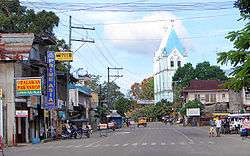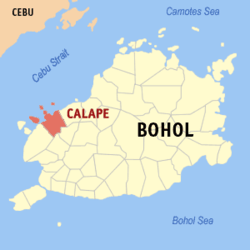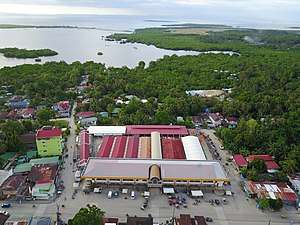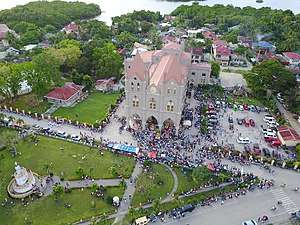Calape, Bohol
Calape, officially the Municipality of Calape (Cebuano: Lungsod sa Calape; Tagalog: Bayan ng Calape), is a 3rd class municipality in the province of Bohol, Philippines. According to the 2015 census, it has a population of 30,863 people.[3]
Calape | |
|---|---|
| Municipality of Calape | |
 Center of Calape | |
 Map of Bohol with Calape highlighted | |
OpenStreetMap 
| |
.svg.png) Calape Location within the Philippines | |
| Coordinates: 9°53′N 123°53′E | |
| Country | |
| Region | Central Visayas (Region VII) |
| Province | Bohol |
| District | 1st District |
| Founded | 1802 |
| Barangays | 33 (see Barangays) |
| Government | |
| • Type | Sangguniang Bayan |
| • Mayor | Nelson N. Yu |
| • Vice Mayor | Sulpicio N. Yu Jr. |
| • Congressman | Edgardo M. Chatto |
| • Electorate | 22,474 voters (2019) |
| Area | |
| • Total | 75.36 km2 (29.10 sq mi) |
| Population (2015 census)[3] | |
| • Total | 30,863 |
| • Density | 410/km2 (1,100/sq mi) |
| • Households | 7,396 |
| Economy | |
| • Income class | 3rd municipal income class |
| • Poverty incidence | 22.7% (2015)[4] |
| • Revenue (₱) | 100,984,244.84 (2016) |
| Time zone | UTC+8 (PST) |
| ZIP code | 6328 |
| PSGC | |
| IDD : area code | +63 (0)38 |
| Climate type | tropical monsoon climate |
| Native languages | Boholano dialect Cebuano Tagalog |
| Patron saint | Vincent Ferrer |
Located 41 kilometres (25 mi) north of Tagbilaran, the first settlers of Calape were said to be migrants from Cebu, and from other municipalities of Bohol.
Its name is derived from cape, referring to either a species of rattan or to the local varietal of coffee, Kape Barako, both of which still grow abundantly there to this day.[5]
History
By the time Spaniards arrived, there was already a native settlement in Calape. In 1802, the Spanish governor of Cebu established it as an independent municipality.
In 1957, Abucayan Norte was created from the sitios of Cabulihan and Cabinong, and Abucayan Sur from the sitios of Rama and Bino. The sitios of Binogawan, Masonoy, Bentig, Cahayag, and Lawis were also constituted into barrios.
Geography
The town center faces the Cebu Strait on the western side of Bohol Island, about 41 kilometres (25 mi) from Tagbilaran. The jurisdiction of Calape includes the islands of Pangangan (eight barangays) and Mantatao, as well as two uninhabited islets, Poom Island and Basihan Island.
There are four rivers that flow through the territory: Tultugan and Liboron Rivers that drain into Calape Bay, and Calunasan and Abucayan Norte Rivers that drain into Tipcan Bay.
Most of the coastal area is a fairly level plain that gradually rises into rolling hills of coralline limestone. The highest point in Calape is Mount Candungao in the eastern portion of the town, with an elevation of 150 metres (500 ft) above sea level.[6]
Barangays
Calape comprises 33 barangays, of which 18 are coastal.
| PSGC | Barangay | Population | ±% p.a. | |||
|---|---|---|---|---|---|---|
| 2015[3] | 2010[7] | |||||
| 071210001 | Abucayan Norte | 4.5% | 1,402 | 1,326 | 1.07% | |
| 071210002 | Abucayan Sur | 3.0% | 912 | 786 | 2.87% | |
| 071210003 | Banlasan | 2.4% | 736 | 755 | −0.48% | |
| 071210004 | Bentig | 6.3% | 1,949 | 1,797 | 1.56% | |
| 071210005 | Binogawan | 1.4% | 428 | 466 | −1.61% | |
| 071210006 | Bonbon | 4.2% | 1,296 | 1,222 | 1.13% | |
| 071210007 | Cabayugan | 3.0% | 920 | 880 | 0.85% | |
| 071210008 | Cabudburan | 1.6% | 507 | 548 | −1.47% | |
| 071210009 | Calunasan | 2.3% | 718 | 798 | −1.99% | |
| 071210010 | Camias | 1.5% | 468 | 505 | −1.44% | |
| 071210011 | Canguha | 1.0% | 300 | 283 | 1.12% | |
| 071210012 | Catmonan | 4.4% | 1,354 | 1,221 | 1.99% | |
| 071210013 | Desamparados (Poblacion) | 2.5% | 786 | 880 | −2.13% | |
| 071210014 | Kahayag | 1.7% | 530 | 512 | 0.66% | |
| 071210015 | Kinabag‑an | 2.1% | 639 | 511 | 4.35% | |
| 071210016 | Labuon | 1.8% | 542 | 562 | −0.69% | |
| 071210017 | Lawis | 2.1% | 635 | 617 | 0.55% | |
| 071210018 | Liboron | 4.7% | 1,453 | 1,434 | 0.25% | |
| 071210019 | Lo‑oc | 1.5% | 458 | 506 | −1.88% | |
| 071210020 | Lomboy | 1.6% | 488 | 490 | −0.08% | |
| 071210021 | Lucob | 4.6% | 1,431 | 1,330 | 1.40% | |
| 071210022 | Madangog | 2.3% | 724 | 622 | 2.93% | |
| 071210023 | Magtongtong | 2.1% | 639 | 404 | 9.12% | |
| 071210024 | Mandaug | 4.4% | 1,358 | 1,451 | −1.25% | |
| 071210025 | Mantatao | 2.8% | 849 | 967 | −2.45% | |
| 071210027 | Sampoangon | 1.3% | 407 | 373 | 1.67% | |
| 071210028 | San Isidro | 7.1% | 2,195 | 2,412 | −1.78% | |
| 071210029 | Santa Cruz (Poblacion) | 8.4% | 2,590 | 2,401 | 1.45% | |
| 071210030 | Sojoton | 1.6% | 491 | 664 | −5.59% | |
| 071210031 | Talisay | 1.5% | 470 | 415 | 2.40% | |
| 071210032 | Tinibgan | 2.2% | 685 | 733 | −1.28% | |
| 071210033 | Tultugan | 2.9% | 900 | 830 | 1.55% | |
| 071210034 | Ulbujan | 5.2% | 1,603 | 1,445 | 2.00% | |
| Total | 30,863 | 30,146 | 0.45% | |||
Climate
| Climate data for Calape, Bohol | |||||||||||||
|---|---|---|---|---|---|---|---|---|---|---|---|---|---|
| Month | Jan | Feb | Mar | Apr | May | Jun | Jul | Aug | Sep | Oct | Nov | Dec | Year |
| Average high °C (°F) | 28 (82) |
28 (82) |
29 (84) |
31 (88) |
31 (88) |
30 (86) |
30 (86) |
30 (86) |
30 (86) |
29 (84) |
29 (84) |
28 (82) |
29 (85) |
| Average low °C (°F) | 23 (73) |
23 (73) |
23 (73) |
23 (73) |
24 (75) |
24 (75) |
24 (75) |
24 (75) |
24 (75) |
24 (75) |
24 (75) |
23 (73) |
24 (74) |
| Average precipitation mm (inches) | 98 (3.9) |
82 (3.2) |
96 (3.8) |
71 (2.8) |
104 (4.1) |
129 (5.1) |
101 (4.0) |
94 (3.7) |
99 (3.9) |
135 (5.3) |
174 (6.9) |
143 (5.6) |
1,326 (52.3) |
| Average rainy days | 18.0 | 14.1 | 17.1 | 16.8 | 23.7 | 25.7 | 25.8 | 23.3 | 24.2 | 25.9 | 24.0 | 20.6 | 259.2 |
| Source: Meteoblue (Use with caution: this is modeled/calculated data, not measured locally.) [8] | |||||||||||||
Demographics
|
| ||||||||||||||||||||||||||||||||||||||||||||||||
| Source: Philippine Statistics Authority[3][7][9][10] | |||||||||||||||||||||||||||||||||||||||||||||||||
Religion
92% of Calape's population is Roman Catholic. The remaining 8% is divided among other religious groups.
Gallery
 Calape Public Market
Calape Public Market St. Vincent Ferrer Parish Church
St. Vincent Ferrer Parish Church Calape Central Elementary School
Calape Central Elementary School
Notable residents
- Yoyoy Villame, a novelty singer
References
- "Municipality". Quezon City, Philippines: Department of the Interior and Local Government. Retrieved 31 May 2013.
- "Province: Bohol". PSGC Interactive. Quezon City, Philippines: Philippine Statistics Authority. Retrieved 12 November 2016.
- Census of Population (2015). "Region VII (Central Visayas)". Total Population by Province, City, Municipality and Barangay. PSA. Retrieved 20 June 2016.
- "PSA releases the 2015 Municipal and City Level Poverty Estimates". Quezon City, Philippines. Retrieved 12 October 2019.
- "Calape". "www.bohol-philippines.com". Retrieved 2019-04-29.
- "Topography". Municipality of Calape. Retrieved 3 October 2012.
- Census of Population and Housing (2010). "Region VII (Central Visayas)". Total Population by Province, City, Municipality and Barangay. NSO. Retrieved 29 June 2016.
- "Calape: Average Temperatures and Rainfall". Meteoblue. Retrieved 9 May 2020.
- Censuses of Population (1903–2007). "Region VII (Central Visayas)". Table 1. Population Enumerated in Various Censuses by Province/Highly Urbanized City: 1903 to 2007. NSO.
- "Province of Bohol". Municipality Population Data. Local Water Utilities Administration Research Division. Retrieved 17 December 2016.
External links
| Wikimedia Commons has media related to Calape, Bohol. |